The road seems as if it has been etched beneath the cliff, tunneling its way between the river and the rock, orange stone overhead and teal water below. Breaks in the cave-like covering open to the sky, revealing the steep canyon walls on which stand the ancient sarcophagi of those respected from a culture past. Anthropomorphized sculptures set high up on the rock faces, containing the mummified human remains, bundled into fetal positions, put there by the Chachapoyans, a people known as the “Warriors of the Clouds.” Those who scaled these walls to place their honored ones in these extremely precarious places of rest clearly did so with great risk to their own well-being.
The road passes over a bridge and through small pueblos, eventually forking. One way heads upward toward the town of Chachapoyas with gentle switchbacks as you ascend the mountain, gaining views of the canyon below. There are a few different ways to enter into the Spanish-influenced town, the majority of them dirt roads. The main square is the heart of the town, as they all usually are, lined with restaurants, cafés, eyeglass shops, and tour companies. The surrounding streets are narrow with Spanish-style balconies and courtyards at the center of the homes.
Related: Adventuring-Touring Peru On An Indian Scout Sixty
With my bike parked in the courtyard, I slept in an old house near the main plaza that felt notably haunted, as many of the old colonial cities in South America do. By some accounts, the spread of smallpox by the arrival of the colonists decreased the population of the Chachapoyas region by more than 90 percent over the span of 200 years. Curiously, the Spaniards documented the stubborn and courageous Chachapoyans to have caucasoid features; light-skinned and blonde-haired, and they even left behind mummies with ceramic blue eyes in place.
In the morning, I traveled back down the mountain to where the river meets the road, and followed the other side of the fork westward, as the mix of pavement and rough patches of dirt continued to snake along the river’s wandering body. This way leads to the ancient ruins of Kuélap, a walled citadel high up on a mountain. A dirt road leads you through the small pueblo of Nuevo Tingo, past stray dogs and worn-down churches, to arrive up on the ridge, where there is a safe place to park your motorcycle. It is here that the first cable car in all of Peru will carry you across a stunning valley to arrive at the mountaintop fortress, dubbed the “Machu Picchu of the north,” despite being 600–900 years older than the more well-known Inca structure.
If you’re wary of heights, the cable car ride will be extra exciting for you as it steeply plunges down hundreds of feet into the valley below, especially with high winds. Up top, situated at 3,000 meters (9,843 feet) in the citadel ruins of Kuélap, fortified by walls reaching 20 meters (65.6 feet) high, the structure I found most curious is known as the “inkwell,” an inverted cone-shaped stone building used for sacrificial ceremonial purposes. With intricacies such as animals and faces carved outside, and inside, bones dating more than 2,000 years old were found. Another strange aspect was the lone tower on the ridge, which was used not primarily for defense but for launching objects up into the sky to bring about rain. Unlike Machu Picchu, the majority of Kuélap has yet to be excavated and tall trees still stand among the ruins. Green foliage with bright red bromeliads shade the ancient structures from the strong ecuatorial sun.
Outside of the citadel and further into the densely forested mountain ranges of the Amazonian Andes, smooth pavement connects the mysterious relics left by the Chachapoyans to the jungle frontiers. Riding through a dense bug storm, my face shield and fairings became covered in big juicy insect splats, with some survivors bouncing off my chest and arriving inside my helmet, landing on that little ledge where the visor closes near my mouth. At higher elevations, I saw an incredible amount of butterflies. Many of them were the giant blue morphos, whose brilliant, iridescent blue is like a siren flashing, on and off, when the wings beat open and closed. They seem to completely disappear when the wings close and reappear with a flash of vibrant blue when open, leaving one to ponder why they’d evolve to oscillate between making their presence so visually known and unknown. Much of the curving route was lined by prehistoric-looking tree ferns, with their elevated fronds towering over the road.
The road travels north and then southeast, arching around the protected forest of Alto Mayo, between the northern Peruvian provinces of Amazonas and San Martin.
As with the cryptic warriors of the clouds, hidden away from the outside world, there lives another inconspicuous creature, obscured by its habitat. Within these rain-soaked cloud forests live the yellow-tailed woolly monkey (Lagothrix flavicauda), one of the rarest and least known monkeys in the “neotropics”—the tropical New World. These monkeys of the clouds were first documented by the great explorer and naturalist, Alexander von Humboldt in 1802 when he noticed the unique pelts being used as saddles on mules. Despite all his wandering, he never saw a live one. Yellow-tailed woolly monkeys live in such rugged terrain and at such high altitudes, they were long thought to be extinct until living specimens were finally seen by scientists in 1974. A team of researchers set out on foot to find them, but even after many days, did not see a single individual. It wasn’t until they returned to the small village of Pedro Ruiz Gallo, the intersection that takes you between Chachapoyas and Moyobamba, that to their astonishment, they saw a young yellow-tailed woolly monkey being kept as a pet.
Keeping monkeys as pets has been a common practice in and around the Amazon, obtained by killing the mother and taming the clinging infant, an unfortunate reality for all but especially for monkeys as rare as these. The baby monkey is usually too young to survive without the mother and most get sick and die. Yellow-tailed woolly monkeys are highly social, live in groups, and spend their lives in trees. As important seed dispensers, they feed primarily on leaves, fruits, and flowers, maintaining forest biodiversity. Their coat is a soft, dense, rich mahogany fur. They have a white muzzle and a yellow tuft under the tail.
Riding among tall ferns and dense forests is a welcomed treat, as deforestation and illegal logging is rampant in much of the accessible areas of primary forest—even when it is designated as nationally “protected.” Destruction of habitat is the greatest threat to many of our species, including the yellow-tailed woolly monkey, designated as “Critically Endangered” by the IUCN (International Union for Conservation of Nature), to which the next step down is “Extinct in the Wild,” wherein the species only lives in captivity, such as in zoos.
Gliding along this lush, green highway, thankful for quality pavement and happy to be past the insect swarm, I push on to visit the Neotropical Primate Conservation (NPC) organization, which works to protect this incredibly vulnerable species. The ride into Moyobamba, the official location for the NPC, feels as though you’re immersing yourself further into the mountainous jungle of the tropical Andes. This area is situated at 860 meters (2,820 feet), right on the edge—the increasing mountains to the west, and then stretching out flat into the Amazon basin to the east. There is river access nearby which, if you like, will take you all the way into the heart of the Amazon jungle, far away from any roads.
Visiting the NPC, I learned that its aim to protect the yellow-tailed woolly monkey is multifaceted, such as through scientific research to better understand their needs in order to protect them and their habitat, educational outreach to inform the people living near them of their global importance, and sustainable development and community management projects, such as ecotourism and reforestation initiatives in order to involve the locals who have the power and will to conserve biodiversity.
It appears that the futures of man, monkeys, and our forests are inextricably linked. When forests are removed, the water cycle and everything that depends on it goes away too. The clouds above are rapidly changing; the exposure of roaming the earth on a motorcycle makes this more evident to me than ever. We are the only species in existence which destroys our own habitat. It is therefore up to us to decide which trajectory we shall take to determine our own survival.
If humanity disappeared, there is no doubt the planet would recover, with time, in its own way. Is harmony possible? It seems we only need to look to the past to see that our struggles come from within.
The fall of the ancient city of Kuélap came from within. The Chachapoyans had very particular funerary rituals, yet their skeletal remains—those of all ages—were found inside and outside houses, suggesting a massacre. Their skulls show they were killed by blows to the head with stones. According to anthropologists, this therefore was not the work of the Incas or the Spanish, otherwise they would have found the telltale evidence of swords or weapons. This massacre therefore seems to be the end result of conflict within the community itself, of local families living within the walled fortress turning on each other. After the massacre, the fortified city of Kuélap was burned.
The Chachapoyan warriors of the clouds only live on in history and ruins, but we still have the chance to ensure that the rare and unique yellow-tailed woolly monkeys of the clouds remain among us.
If you’d like to support the efforts of the Neotropical Primate Conservation, you can find them at neoprimate.org.
















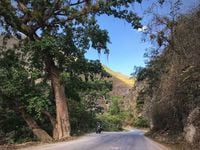
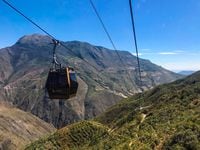

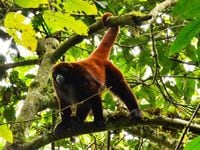


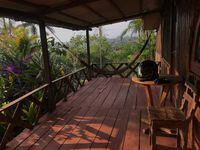
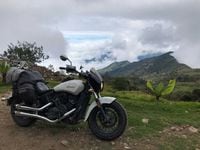
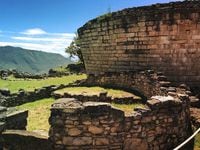
/cloudfront-us-east-1.images.arcpublishing.com/octane/JRSFLB2645FVNOQAZCKC5LNJY4.jpg)
/cloudfront-us-east-1.images.arcpublishing.com/octane/ITNLTIU5QZARHO733XP4EBTNVE.jpg)
/cloudfront-us-east-1.images.arcpublishing.com/octane/VZZXJQ6U3FESFPZCBVXKFSUG4A.jpg)
/cloudfront-us-east-1.images.arcpublishing.com/octane/QCZEPHQAMRHZPLHTDJBIJVWL3M.jpg)
/cloudfront-us-east-1.images.arcpublishing.com/octane/HXOUJXQWA5HBHGRO3EMJIGFMVI.jpg)

/cloudfront-us-east-1.images.arcpublishing.com/octane/3TIWWRV4JBBOLDVGRYECVVTA7Y.jpg)
/cloudfront-us-east-1.images.arcpublishing.com/octane/KIX5O23D5NAIBGFXBN3327DKZU.jpg)
/cloudfront-us-east-1.images.arcpublishing.com/octane/7GJYDUIPXRGMTMQKN6ONYOLBOU.jpg)
/cloudfront-us-east-1.images.arcpublishing.com/octane/MUQLOVLL2ZDGFH25ILABNBXKTI.jpg)
/cloudfront-us-east-1.images.arcpublishing.com/octane/TNOU5DNE2BC57MFPMGN2EIDXAM.jpg)
/cloudfront-us-east-1.images.arcpublishing.com/octane/GTCXACQGJ5HAPDTGWUQKDEH44E.jpg)
/cloudfront-us-east-1.images.arcpublishing.com/octane/S35YGSEMEZB4BLTDJTSZPF4GLA.jpg)
/cloudfront-us-east-1.images.arcpublishing.com/octane/5UOT6HPX2JFMRJAX6EH45AR4MQ.jpg)
/cloudfront-us-east-1.images.arcpublishing.com/octane/OKWOJWAKP5EP3OACCRRWPCIX2Q.jpg)
/cloudfront-us-east-1.images.arcpublishing.com/octane/2WF3SCE3NFBQXLDNJM7KMXA45E.jpg)
/cloudfront-us-east-1.images.arcpublishing.com/octane/G4MG6OUCJNBSHIS2MVVOTPX65E.jpg)
/cloudfront-us-east-1.images.arcpublishing.com/octane/IIGGWFOTOJGB7DB6DGBXCCMTDY.jpg)
/cloudfront-us-east-1.images.arcpublishing.com/octane/QSTCM6AVEZA5JJBUXNIQ3DSOF4.jpg)
/cloudfront-us-east-1.images.arcpublishing.com/octane/U4I7G625B5DMLF2DVIJDFZVV6M.jpg)
/cloudfront-us-east-1.images.arcpublishing.com/octane/B6XD6LS6IVCQPIU6HXDJSM3FHY.jpg)
/cloudfront-us-east-1.images.arcpublishing.com/octane/ICL63FEDDRDTTMINYICCEYGMDA.jpg)
/cloudfront-us-east-1.images.arcpublishing.com/octane/FCGZHQXRBZFLBAPC5SDIQLVF4I.jpg)
/cloudfront-us-east-1.images.arcpublishing.com/octane/WNOB6LDOIFFHJKPSVIWDYUGOPM.jpg)